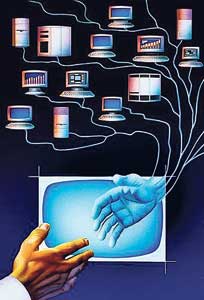
Interface infoA user interface forms the link between appliances ranging from toasters and rice-cookers to aircraft and nuclear reactors and their human users. The dial that regulates the temperature on a toaster or oven is a simple interface, but the task it performs is still a very critical one in terms of rendering the entire machine useful and useable. We need not look any further than a complex, cluttered and ambiguous user interface on an automatic washing machine or high-end microwave oven, to realise that even the simplest of tasks that an appliance is made to carry out can be made inaccessible and therefore unusable as a result of poor interface design. It also is a testimony of the critical importance of good interface design for more complex machines such as computers and indeed aircraft cockpits.
There are certain characteristics in a PC interface that we use intuitively and therefore hardly notice their function. Paradoxically, the fact that they do not grab our attention is the best testimony of their effectiveness and the elegance of their design. A user interface by itself is not meant to attract the user's attention. They are merely a link between the user and the myriad functions of the machine. Their purpose is to make the functions easily and intuitively accessible to the users and set constraints of use that may be necessary for many reasons such as safety, security, efficiency and functional procedures. UI design is as much an art as it is a science, and inspiration for the recently adopted 'Ribbon' menu system in Microsoft Office had come from a fusion of ideas stemming from ancient papyrus scrolls and the common tabular interfaces in computer applications. Perhaps the creative genius of interface design has been best expressed within the technical constraints of web design and development, but as the computers and the applications we run on them become more powerful and complex, the need for creative new interfaces that can invisible bind users to the core functions of their machines is felt with increasing desperation. Despite the availability of powerful hardware, other limitations – including psychological and human behavioural constraints – have inhibited the development of multimedia interfaces such as the incorporation of image and voice recognition. Despite unimagined developments in hardware capabilities, the core features of computer interfaces have not changed for nearly three decades. It is indeed interesting to ponder "why?" Write in to technopage@gmail.com and share your views. Innovative space Space Generation The US Federal Communications Commission is carrying out tests to determine if the "white space" or unused spectrum between broadcast TV channels can be used for wireless service without interfering with TV broadcasts. Technology companies say that using the spectrum between the TV channels could unleash a wave of innovation. But TV broadcasters and cell phone carriers in the US oppose the use of "white spaces" for wireless services. The first phase of testing, ended in July last year where a Microsoft prototype device failed to detect broadcast signals, but one submitted by Koninklijke Philips Electronics worked just fine. Microsoft has refuted the results claiming the device used in the test was damaged, therefore invalidating the results. Now with Phase II, Microsoft will get a chance to redeem itself. The company has already submitted another prototype device, along with three other companies, Adaptrum, Motorola and Philips. Google, which is bidding in the 700MHz spectrum auction later this month, wasn't named as submitting a device for testing, but the company did submit its own white space testing results in December. Kings of orient to be China's Internet population stood at 210 million at the end of last year, up 53 percent from the same time in 2006 when there were 137 million, the China Internet Network Information Centre said in its semi-annual report on Internet use here. That figure puts China just 5 million users away from becoming the world's largest wired nation – and with only about 16 percent of the population online. At its current growth rate, China will become the world's top Internet market sometime in the next few months. The greatest growth came from users under 18 and over 30, CNNIC said. One of the most surprising statistics from the new report indicates that about 40 percent of users added over the last year, over 29 million came from rural areas. Even in the January 2007 report, the vast majority of Chinese 'Netizens' were based in major urban areas such as Beijing and Shanghai. Also surprising among the new results is that China's most popular Internet application is online music, used by 86.6 percent of those surveyed, followed by instant messaging with 81 percent. E-mail placed only fifth, with 56.5 percent using it. |
|
||||||
|| Front
Page | News | Editorial | Columns | Sports | Plus | Financial
Times | International | Mirror | TV
Times | Funday
Times || |
| |
Reproduction of articles permitted when used without any alterations to contents and the source. |
© Copyright
2008 | Wijeya
Newspapers Ltd.Colombo. Sri Lanka. All Rights Reserved. |
